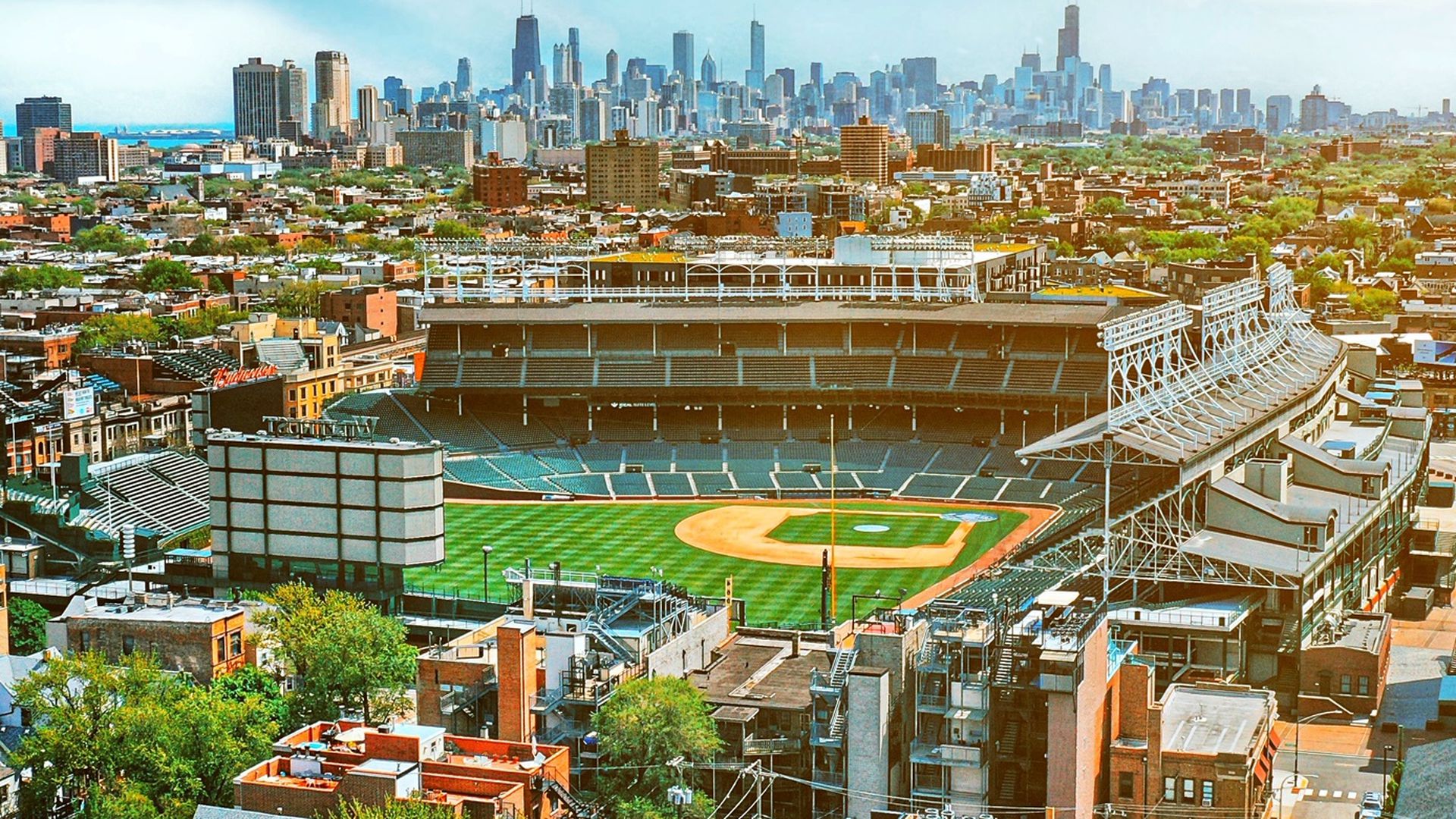
Wrigley Field is my home away from home all summer and has been for many years. It’s my happy place.
I’ve written a guide to Arizona Spring Training every year for the last several ( here’s this year’s ), and thought it was time for a guide to the Cubs’ home in Chicago.
Wrigley Field first opened for business in 1914 — and not for the Chicago Cubs. It was constructed by Charlie Weeghman, who had purchased a franchise in the upstart Federal League, which became known as the Chicago Whales.
When the Federal League folded after 1915, two of its league owners were allowed to buy MLB teams. One of those owners was Weeghman, who bought the Cubs and moved them into his North Side ballpark, then called Weeghman Park, in 1916. The park was renamed Cubs Park in 1921 when William Wrigley Jr. bought a controlling interest in the team, and the ballpark was named in honor of its owner in December 1926.
By the late 1970s the ballpark was being called “ancient” by some sportswriters as new cookie-cutter stadiums were built, but after those parks were found to be wanting (famously, Richie Hebner, who would later play for the Cubs, said of them, “I stand at the plate in Philadelphia and I don’t honestly know whether I’m in Pittsburgh, Cincinnati, St. Louis, or Philly. They all look alike.”), architects would come to Wrigley to see what was working there. Many of the new “retro” parks, notably Oriole Park at Camden Yards in Baltimore, had features modeled after Wrigley. In fact, there’s Wrigley Field ivy growing on the bullpen wall in Baltimore (photo taken in 2017):
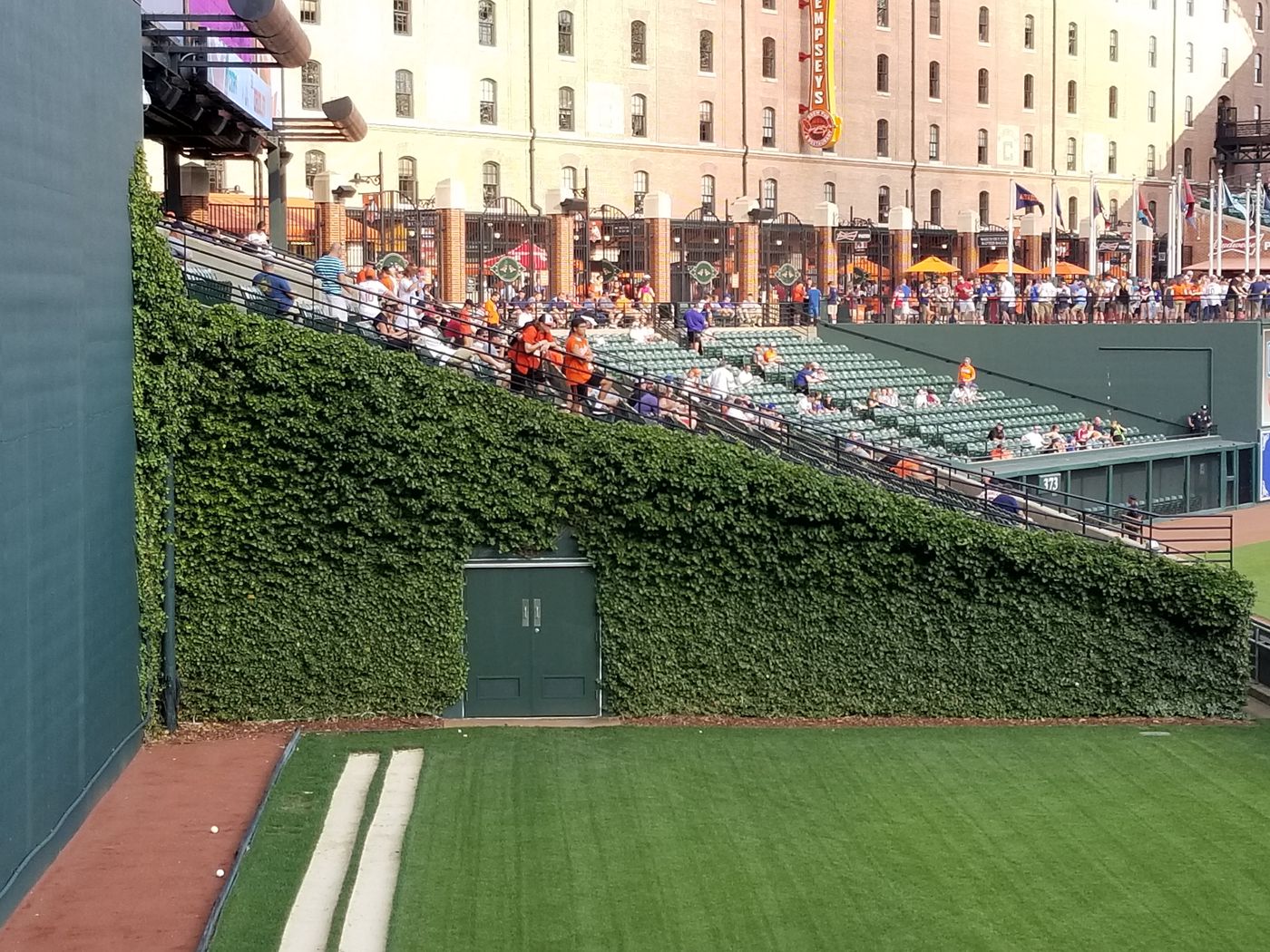
Wrigley Field began to be updated when Tribune Co. bought the team in 1981. Lights were installed in 1988, as Wrigley became the last of the Original 16 parks to host night baseball. The bleachers were expanded from 3,300 seats to about 5,000 in the 2005-06 offseason. This photo was taken after the last game in the “old” bleachers, Sept. 28, 2005:

From 2015-19, “Project 1060,” a nod to the park’s street address on W. Addison Street, was a $750 million (all privately financed, incidentally) top-to-bottom renovation of Wrigley Field intended to bring it another 100 years. Private clubs were added, the bleachers expanded again, two video boards installed and a large clubhouse that was said to be the nicest in MLB was constructed underground. Here’s a look I had at the new clubhouse on a media tour in 2016:
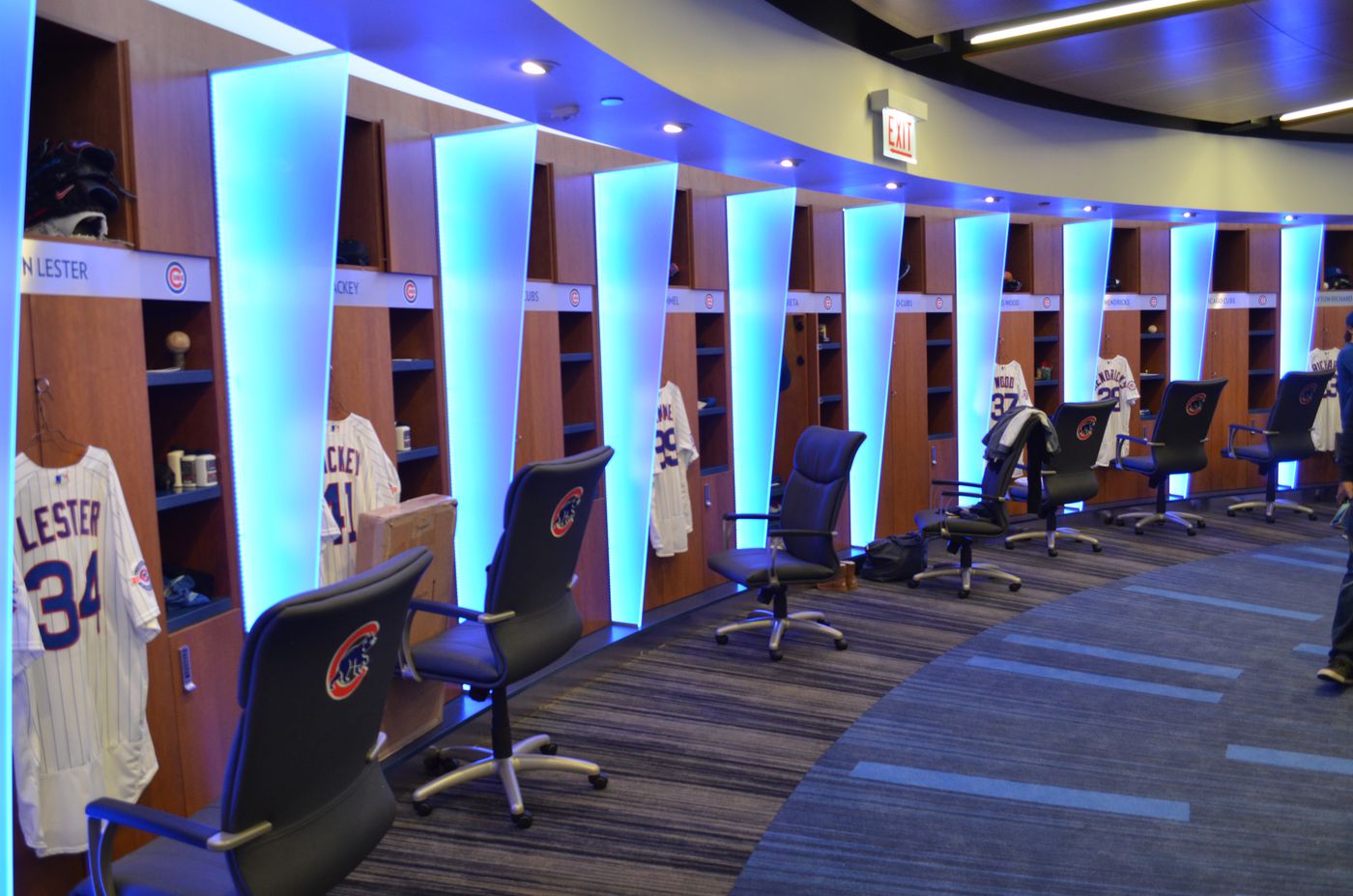
That’s a basic history of the ballpark. Now that you’re on board with that, if you’re coming to a game at Wrigley and you haven’t been there before, here are some tips to make your visit a great one.
First — and I cannot emphasize this enough — take public transit . Parking is difficult to find around Wrigley and even if you do find it, it’ll be expensive. Here’s the Chicago Transit Authority’s guide to getting to Wrigley by train or bus. If you drive, the Cubs do operate a remote parking lot with a shuttle to and from Wrigley. Caveat: The lot is at 3900 N. Rockwell, which is about two miles from Wrigley Field. It operates only for night games and weekend contests, and lines to get back to the lot after games can be very long. I have known people who have used this lot, though, and they seem reasonably happy with it, especially the price: Free!
Here’s more transportation and parking info for Wrigley Field.
Once you get to the ballpark — don’t go in yet! Explore the neighborhood around Wrigley, where there are restaurants and bars right across the street. Some local favorites:
- Murphy’s Bleachers , 3655 N. Sheffield. Directly across from the entrance to the bleachers, this popular bar has served Cubs fans for 80 years.
- Sports Corner , 952 W. Addison. Similar to Murphy’s, right across from the RF corner entrance to Wrigley. Really good sandwiches, particularly the Italian beef.
- Cubby Bear , 1059 W. Addison. Kitty-corner to the famous Wrigley Field marquee, it’s been open for more than 70 years and was named because at the time, the Bears also called Wrigley Field home.
- Bernie’s Chicago , 3664 N. Clark. Across from the Gallagher Way gate to Wrigley, another place popular with the locals.
That’s just a sample, there are dozens of other bars and restaurants within walking distance of the ballpark, great places to stop and eat before the game, drink after, or both!
If you don’t yet have tickets, you should know that Cubs tickets are getting tougher to come by as the team has improved and is contending for a division title this year. While box office tickets are generally more expensive than some on the secondary market, be advised: I have heard of several incidents where people have bought Cubs tickets on StubHub, paid for them, then the seller recalled them and the buyer could not go to the game. Yes, the buyers got their money back, but it’s borderline unethical to allow that. If you do buy on the secondary market, use SeatGeek, which has an official relationship with Major League Baseball.
Once you have tickets, check out this seat map showing all the entrances to Wrigley Field and you should find the one that’s nearest to your seat. Upper deck section numbers have an “L” for left field or “R” for right field and you should go to the upper level on that side of the field.

This is the iconic Wrigley Field marquee as it looked on Opening Day this year. It’s located right above the “Marquee Gate” as shown on the map:
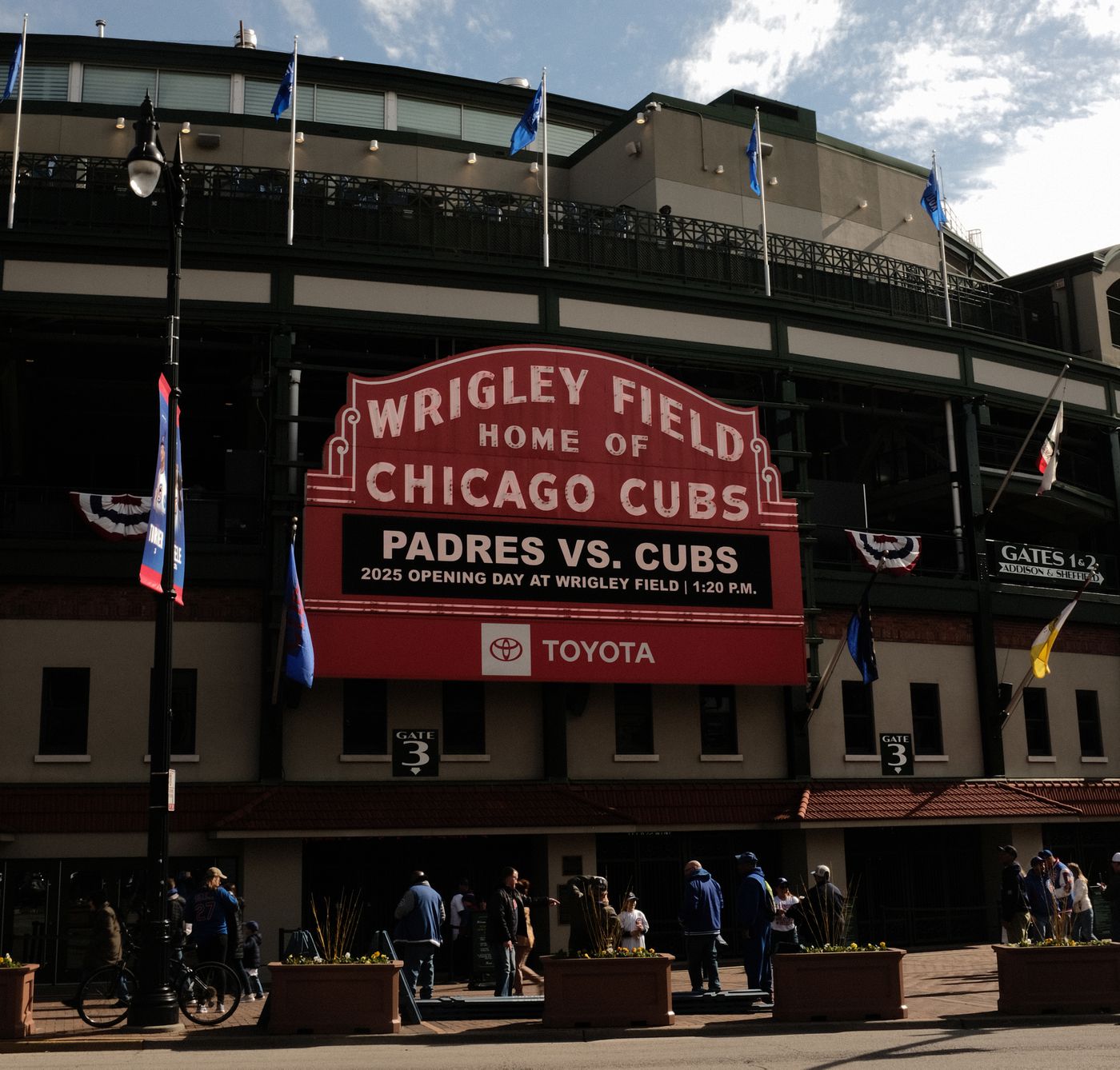
Once you enter the ballpark, if you are a first-time visitor, go to the Fan Services window that’s on the third-base side. There, you can get a “First Timer” certificate (there’s a similar window in the bleachers, not far from the bleacher entrance). Not far from there is a room where the 2016 World Series trophy is located. You can line up there — lines can get long! — to get your photo taken with the trophy.
Underneath the left-field bleachers is located the Cubs Hall of Fame, where you can see plaques honoring many players, coaches, managers, broadcasters and other important people in Cubs history. Here’s an overview of what it looks like, and a closeup photo of a few of the plaques:
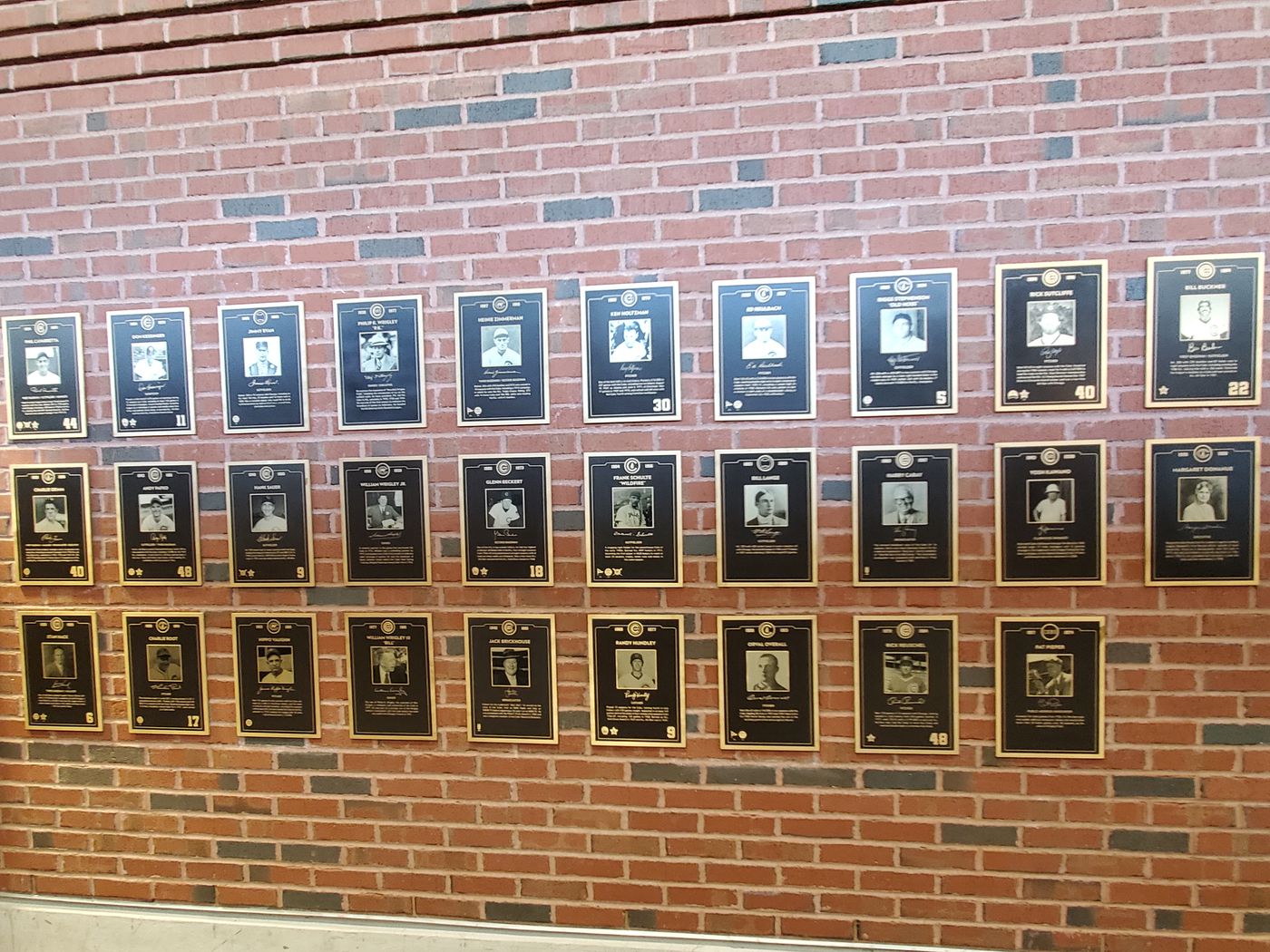
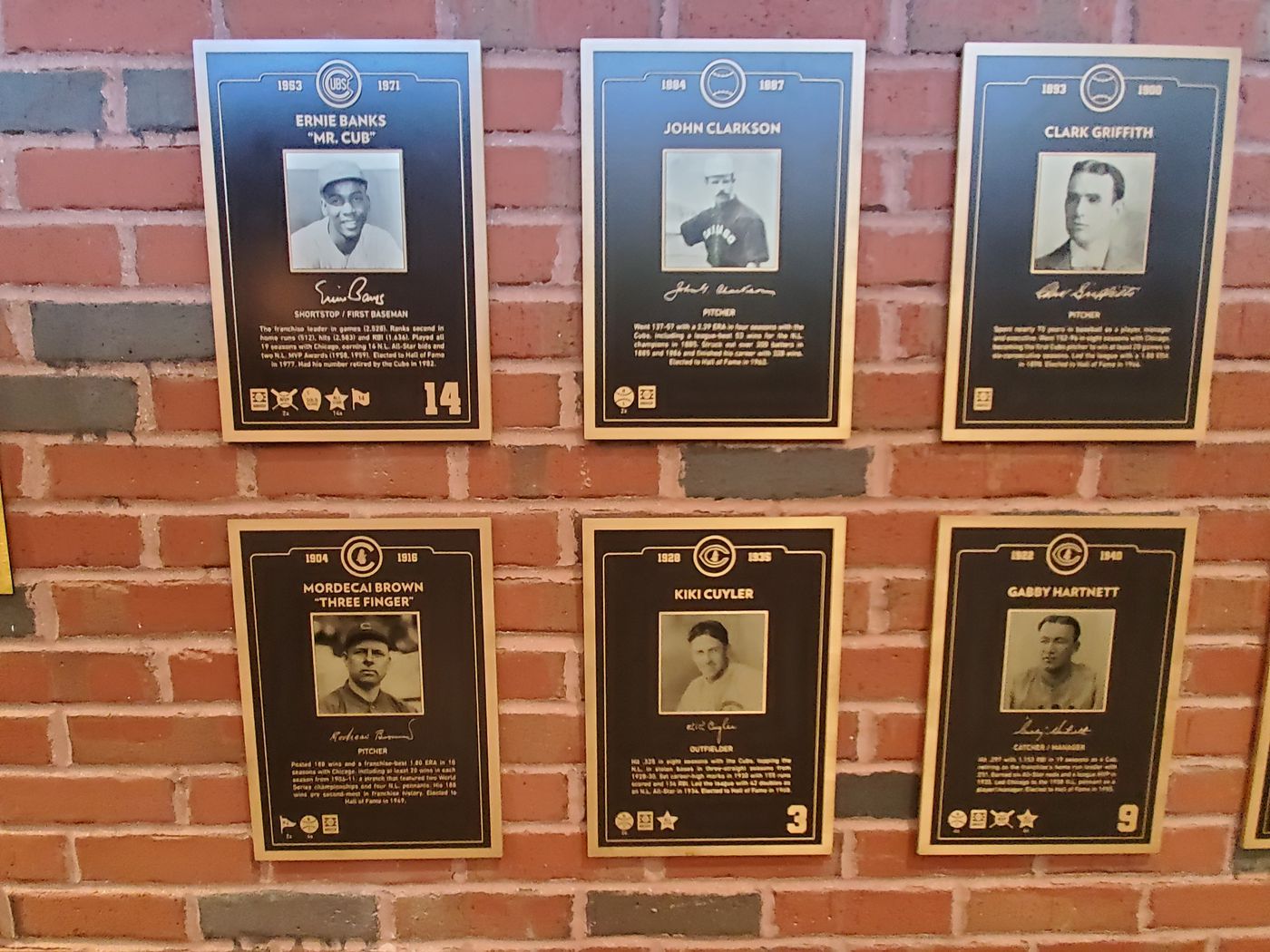
Last year’s inductees were Kerry Wood and Aramis Ramírez:
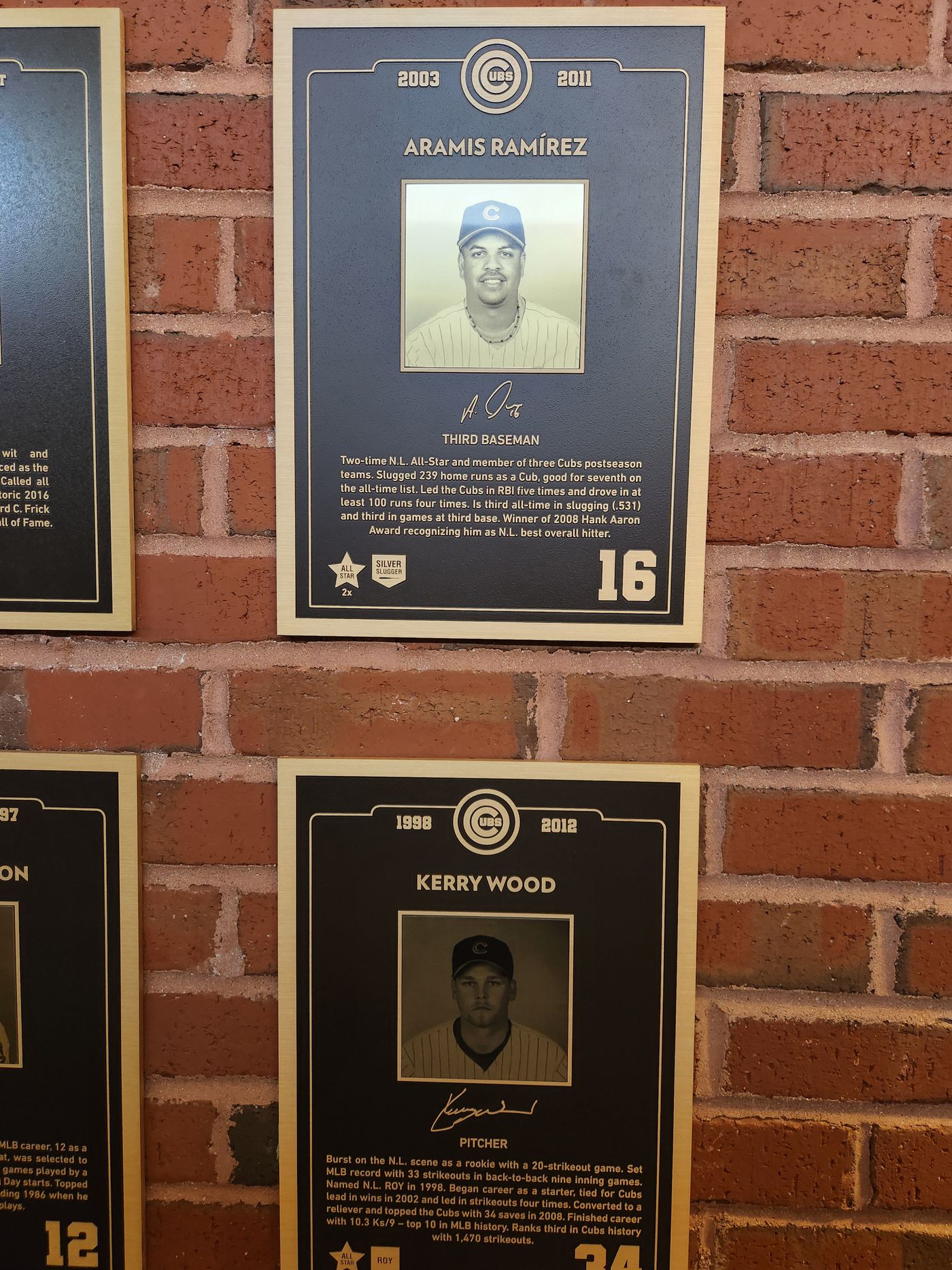
This year, Derrek Lee and Sammy Sosa will be inducted on Sept. 6, likely to be a hot ticket. (It’s also D-Lee’s 50th birthday!)
Then, of course, there’s the field. The video boards are a decade old and have been designed to fit in with the old-fashioned design of the ballpark. When renovations were done, architect T. Gunny Harboe said he was basing many of the updates on what he called Wrigley’s “Golden Age,” the 1930s — that’s certainly true as they won four NL pennants from 1929-38. The boards don’t go in for things like “Kiss Cam” or other things like that, although they do run the “hat hiding ball” game that’s popular in many stadiums. Basically, the boards are there for information (and, of course, advertising) and they look great, in my view.
Here’s the left-field board as seen in 2018, with the bleachers in view (still looks the same today):
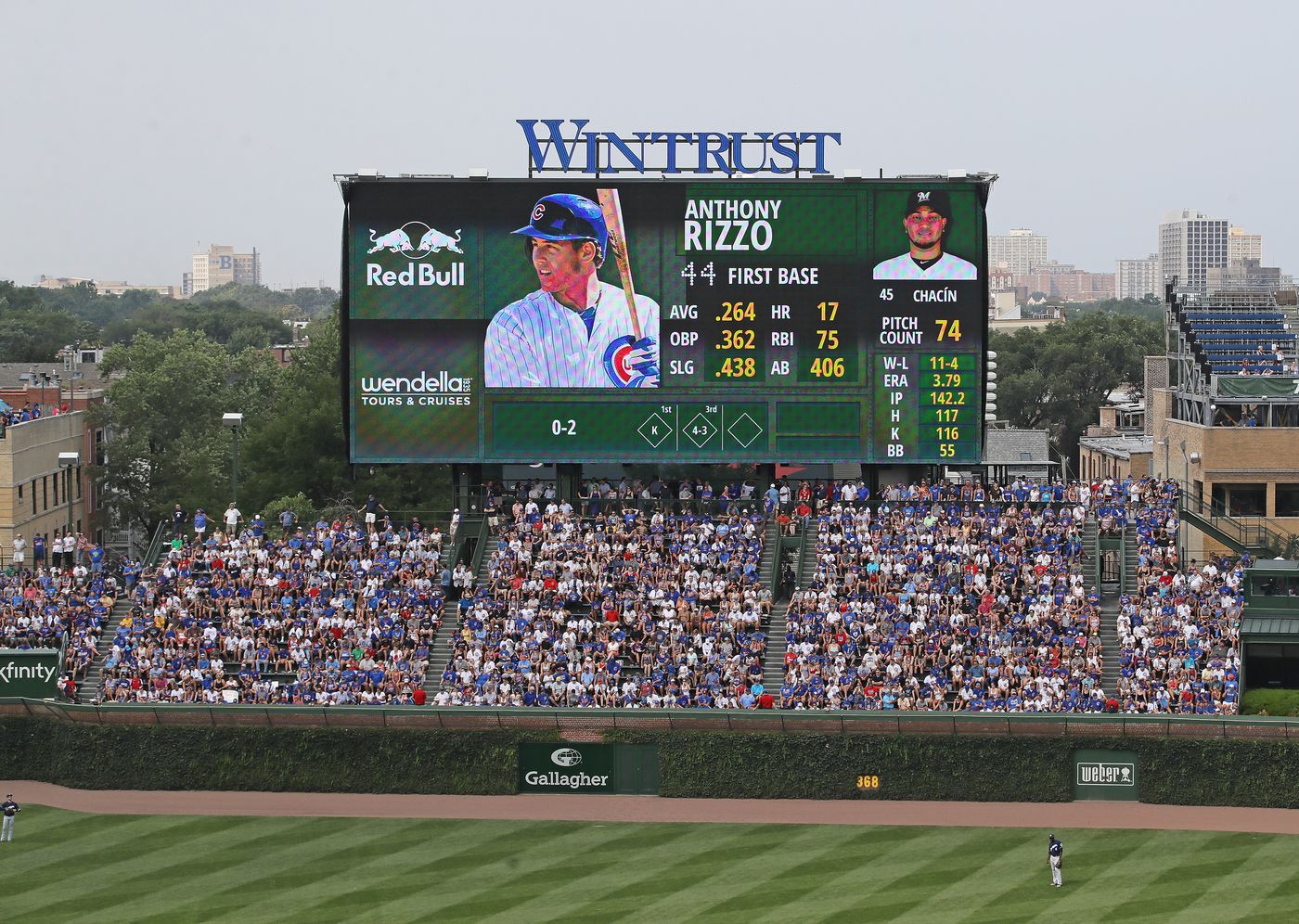
Here’s the right-field side of the ballpark, with the video board on that side, as seen in 2015 (again, the view is the same now):
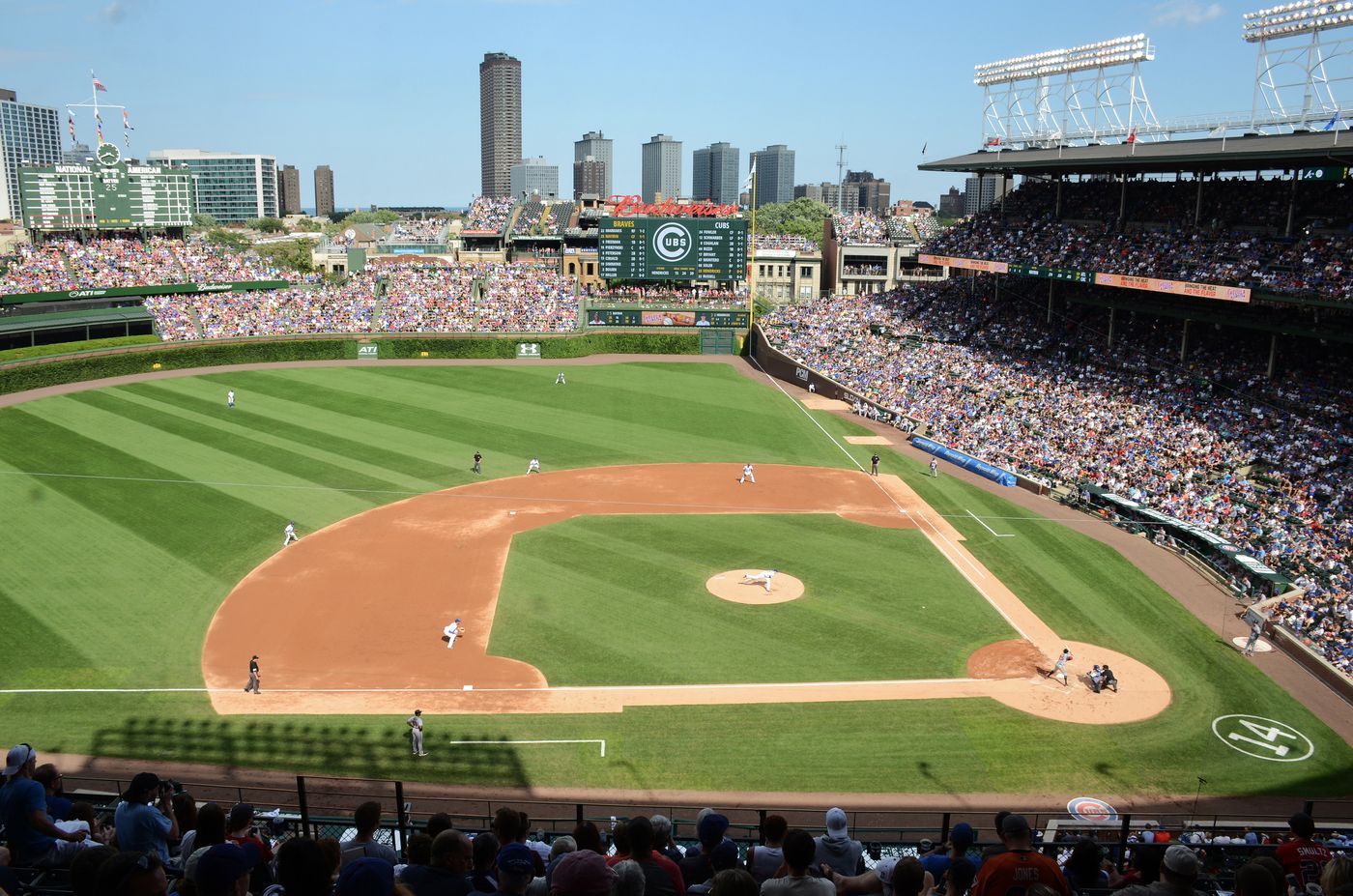
Here’s the view of the entire ballpark from behind home plate, taken May 16, 2025 during a Cubs/White Sox game:
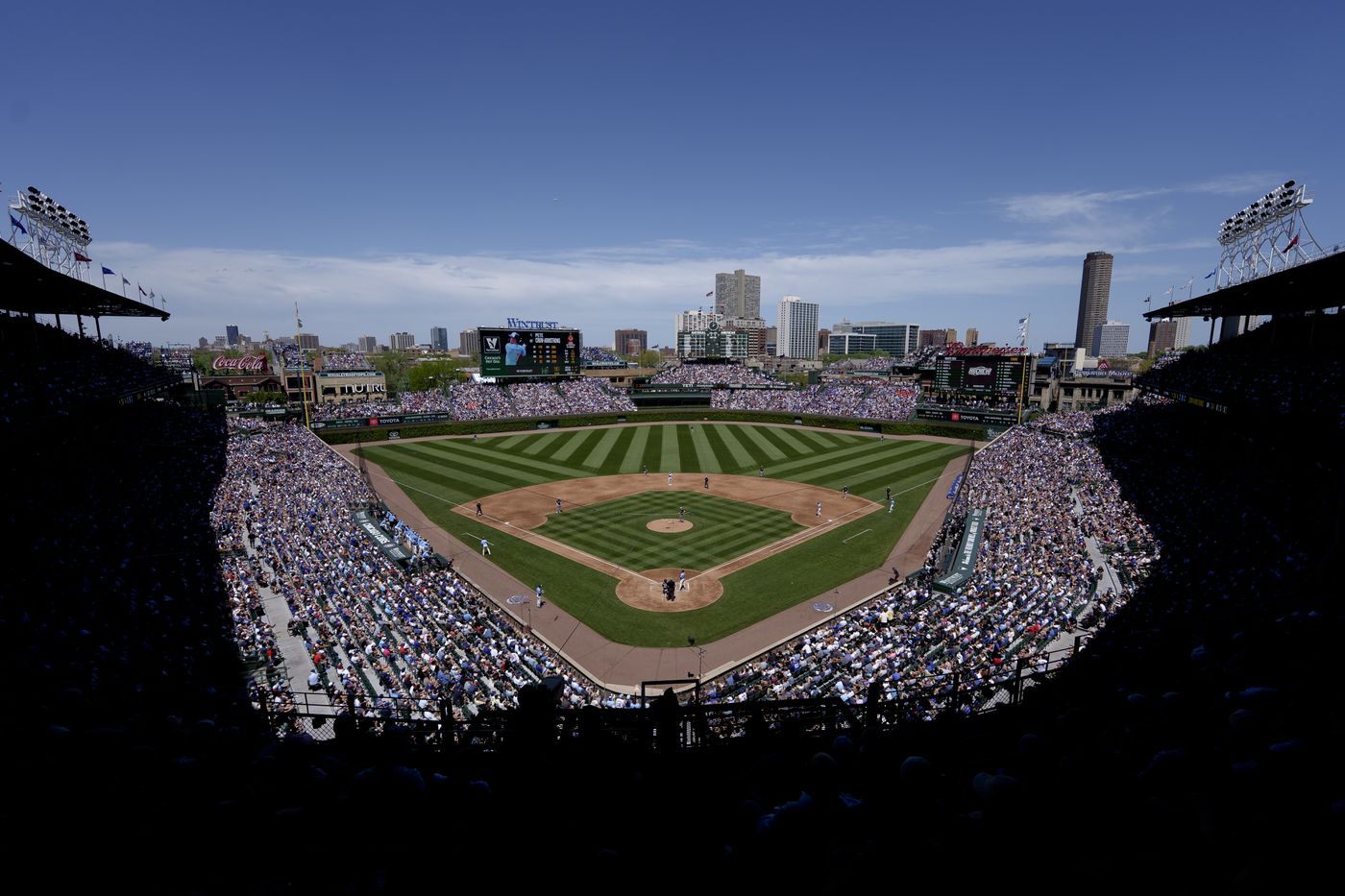
If you are a first-time visitor to Wrigley, walk all around the park and take in the view from many different angles before you go to your seat. Soak up the atmosphere of the neighborhood and the fact that this ballpark is nestled right in the middle of a vibrant city neighborhood, nicknamed “Wrigleyville,” though its official name is East Lakeview.
Outside Wrigley Field yet connected to it are the various rooftop clubs. Decades ago, sitting on a rooftop like that in Chicago was actually illegal. Folks started doing it to watch ballgames in the 1980s. Here’s a photo of some people on a rooftop during the Cubs/Padres NLCS, Oct. 2, 1984:
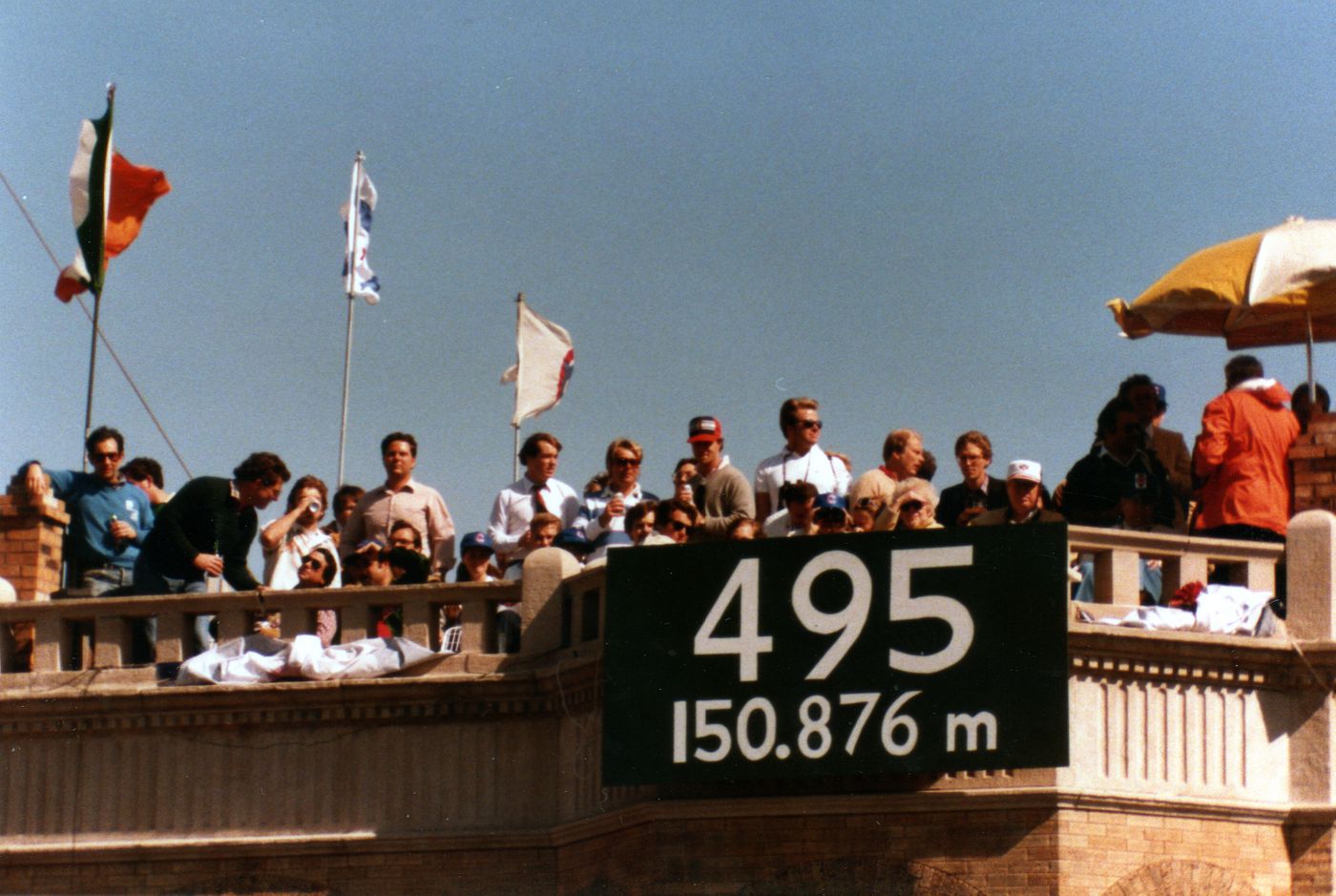
The clubs that currently exist began in the late 1990s. They had some contentious doings with the Cubs years later, as the Cubs sued them claiming they were charging admission to something they didn’t own (a baseball game). Eventually the team and the rooftop clubs came to an agreement that gave the Cubs a percentage of rooftop revenue for a number of years. After that, the Cubs wound up buying almost all the clubs — you can see that if you look around the park or neighborhood. The Ricketts family-owned clubs can be found at WrigleyRooftops.com .
While you can get a pretty good view of the field from most of the rooftop clubs, in practice most folks who buy rooftop tickets are going for the party, not the game. Food and drink at most of these are pretty good, and I’d say it’s probably worth experiencing once. But if you are a baseball fan interested in the game itself, being inside the ballpark is a much better experience.
One of the best things about Wrigley Field is singing “Go Cubs Go” in a setting of 40,000 fans after the Cubs win. The song was written by Steve Goodman, a Chicago native who wrote the popular 1970s song “City of New Orleans.” He was also a die-hard Cubs fan who grew up in the 1950s and early 1960s, a down time for the team, and later wrote a song called “A Dying Cub Fan’s Last Request.” Cubs GM Dallas Green hated the song and wondered if Goodman could write “an upbeat Cubs song.” WGN radio executive Dan Fabian commissioned Goodman to write a song for the station, and “Go Cubs Go” was the result. It began to be sung after Cubs wins at Wrigley Field in 2007. Here’s what it was like after the Cubs won Game 5 of the 2016 World Series:
Goodman died four days before the Cubs clinched the NL East in 1984, their first postseason berth since 1945. Not long after the Cubs started doing the song at Wrigley, Eric Zorn of the Chicago Tribune asked Goodman’s mother, still living, what she thought of it. “It blows my mind,” she replied. “The Cubs win and I get to hear my kid sing again.”
There’s much more information on Wrigley Field here . And if you can’t make it to a game at Wrigley, definitely check out the ballpark tour — informative and worth the money. (And go on a non-game day, you’ll see much more than on a game day.) The staff giving tours are knowledgeable — in fact, Cubs gameday staff were voted the top gameday staff in all of Major League Baseball in 2023 . Many of these staff members have become personal friends of mine. They are friendly and efficient not only for tours, but on game days.
Wrigley Field is more than just the home for the Cubs. Over the years it’s become one of the top tourist attractions in the state of Illinois . It’s fun to see a game there, fun to enjoy the atmosphere of a full house nearly every day, fun to check out the neighborhood.
Play ball!
